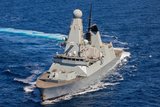Australia requests Aegis combat system equipment
The US State Department has made a determination approving a potential foreign military sale of equipment for the integration of the CEAFar 2 phased array radar system with the Aegis combat system to Australia, the Defense Security Cooperation Agency announced on 26 June.
Under a package worth $185 million, Australia has requested long lead items, engineering and development activities, establishment of engineering development sites and commencement of development activities associated with the integration of the CEAFar 2 phased array radar system with the Aegis combat system.
The request includes Aegis weapon system technical equivalent components including command display system consoles (including two consoles in gun weapon system configuration); multi-mission display systems and cabinets; and global C2 system - maritime.
The package also includes cooperative engagement capability sites systems, to include processing rack, simulation equipment and workstation; AN/SPQ-15 converter/receiver and signal data converter equipment; defence visual information distribution service cabinet; AN/SQQ-89 sonobouy processing core computing system racks, with console and laptop; Aegis simulator racks and workstations; Aegis training system; and various ancillary equipment and support products.
Australia has plans to add nine Aegis capable Future Frigates over the next 20 years and upgrade their existing three Aegis capable Hobart class destroyers with the latest technology and capability. This equipment will significantly improve capability and interoperability with US Navy Aegis combatants in the region.
If the sale goes ahead, Lockheed Martin Rotary and Mission Systems will be the prime contractor.
Related Equipment in Defence Insight
More from Naval Warfare
-
![Sweden’s decision on four new warships inches closer as it eyes UK, France and Spain]()
Sweden’s decision on four new warships inches closer as it eyes UK, France and Spain
Sweden decided last year that it wanted a significantly larger warship for its Luleå Class programme than originally planned, with three likely contenders that could potentially deliver within the country’s tight schedule.
-
![How the use of artificial intelligence will affect the US Coast Guard’s acquisitions]()
How the use of artificial intelligence will affect the US Coast Guard’s acquisitions
The USCG is pursuing AI tools to improve the way the service conducts its procurement and fielding processes.
-
![US Coast Guard pursues solutions to increase maritime domain dominance]()
US Coast Guard pursues solutions to increase maritime domain dominance
The USCG is seeking technologies, services and applications to better connect its assets and speed up the decision-making process.
-
![Canadian Coast Guard’s OOSV delivery is “major milestone” in fleet modernisation]()
Canadian Coast Guard’s OOSV delivery is “major milestone” in fleet modernisation
The Polar Class 6 platform is the largest CCG science-dedicated vessel and will operate on the country’s east coast.






















